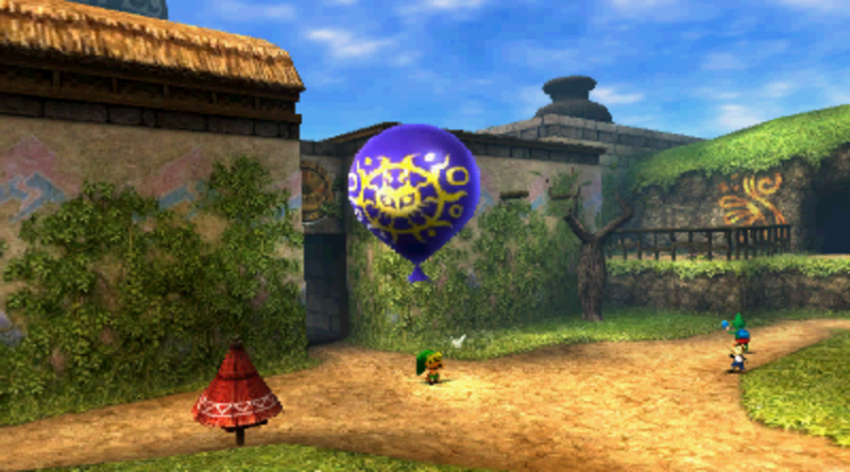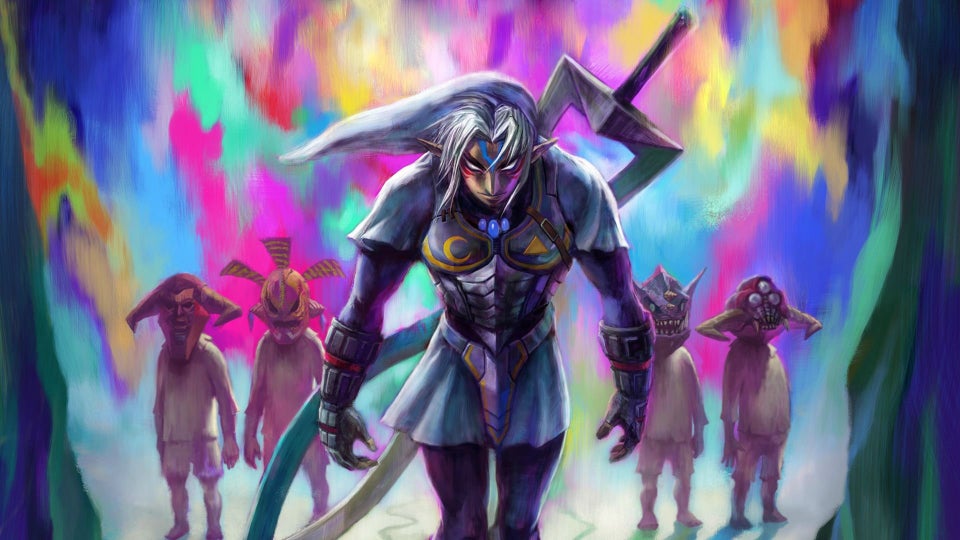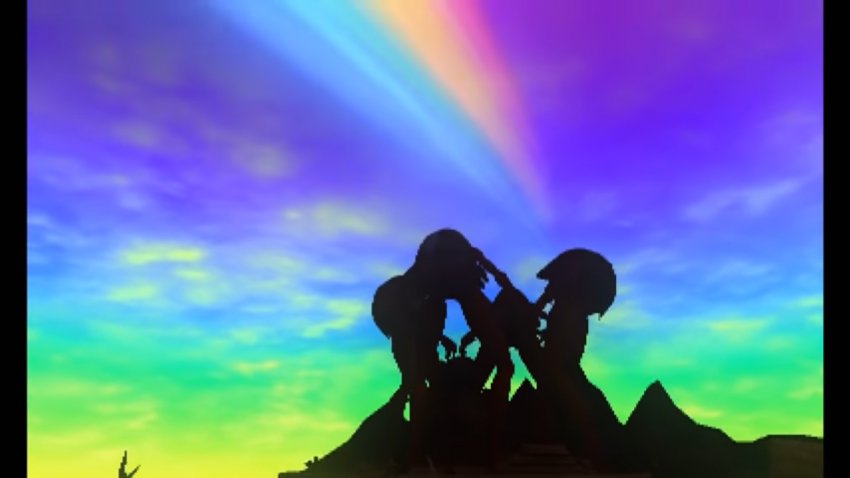Masks, Gods, and the Duality of the Sun and Moon
Posted on April 23 2020 by Charles Xavier

The Legend of Zelda: Majora’s Mask is probably my favorite Zelda game alongside Ocarina of Time. While other games have let Link explore lands besides Hyrule, in comparison Termina feels more interesting than, say, Holodrum or Hytopia. Termina’s compacted nature and character-driven stories make the game deeply impactful, and it certainly left an impression on me. It’s also great that Termina has its own separate history laid out, and might hint towards deeper lore that isn’t explicitly told. Since the release of Majora’s Mask, a question that has remained is where Majora’s Mask originated, and what exactly the nature of this mask is. I think the answer is right under our noses.
Zelda Encyclopedia has stated that Termina is a dream world that Skull Kid created via the power of Majora’s Mask. However, I prefer the theory that the doomed land is an actual parallel world that has been stumbled upon, and the Encyclopedia does give us the option to adopt some imaginative liberties:
“The timeline can be interpreted in a number of ways, and may change depending on new discoveries that have come to light and on the players’ imaginations.” – (Zelda Encyclopedia (Dark Horse Books), pg. 10)
Another interesting portion of the book is it’s description of what Termina is:
“Termina is a parallel world with its own distinct culture, which is perhaps influenced by Majora’s ancient tribe.” (Zelda Encyclopedia (Dark Horse Books), pg. 36)
For a long time I disregarded that Majora’s Mask could be from Termina, but lately the notion doesn’t seem so odd to me anymore. According to my interpretation of the game, the only way the world could be influenced by the ancient tribe which created the evil mask is if they are from Termina. This land fits perfectly as the area of origin for Majora’s Mask due to its lack of major governing deities; it is lawless and chaotic, so lesser gods can actually use this world as their playground to do very impactful things. We’re not talking about creating a mere tornado on an ocean, which Cyclos was able to get away with doing in The Wind Waker – Majora’s Mask is going to destroy all life on the planet!
With the deduction that Majora’s Mask is from Termina, we might be able to discover what the mask actually is as well. To achieve this, we must examine depictions of the mask throughout the land, and the mask’s design, all of which lean towards it being a Solar deity. I’m not the first person to consider this: it is simply the theory I feel works the best.
Majora’s Mask Might be a solar deity, and Fierce Deity’s Mask a lunar god

Firstly, in the boss room where Majora’s Mask is fought, the symbol of the area where the mask is resting is a sun shaped emblem – this symbol was also kept in the 3DS remake. On the balloon in North Clock Town, the mask is depicted within a sun shaped decoration; notably, this was a design choice made exclusively for the 3DS remake.
Continuing, inside the Stone Tower Temple, it has been theorized that the large sculpted head in the first room of the dungeon is a depiction of Majora’s Mask. It looks nothing like the mask while the temple is in it’s normal position, but after being flipped, a comparison certainly can be drawn between the two. If true, this is the largest monument for Majora’s Mask that can be found, and it’s significant because Stone Tower Temple’s theme is harnessing sunlight, and ascension towards the sky.
Additionally, if we look at the color scheme of Majora’s Mask, it actually follows the colors on the visible spectrum, the color spectrum coming from sunlight itself. It’s also worth pointing out that the boss room for the mask is rainbow colored.
Lastly, when Link defeats the mask’s final transformation, Majora’s Wrath, it explodes and releases what appears to be a solar burst.
Consider as well what Majora’s Mask is making the possessed Skull Kid do: the Moon is going to collide into the planet, resulting in the destruction of both celestial bodies, leaving only the sun. If the mask is a solar deity gone bad, its motives to destroy the natural balance of nature are in line with expectations. Although, for more evidence in favor of Majora’s Mask housing a Sun god we need to take a look at what might be it’s antithesis: the Fierce Deity’s Mask.

Within the Moon our hero can obtain this transformation mask, so right off the bat this draws a strong connection between it and the Moon. When Link dons the mask, transforming into the Fierce Deity, we can see its armor has a Crescent Moon symbol and a Prism design on its left and right chest area, respectively. The crescent symbol is self explanatory, but what about the prism? To start, a Prism can reflect light just as a moon reflects sunlight. A Prism is also a means to refract light to see the visible spectrum, and this is maybe the most important symbolism here. If the Fierce Deity’s mask represents the purity of the moon’s white light, and that light is then refracted through a prism, the opposite that we get is the rainbow – or Majora’s Mask. This might be a stretch, but it’s something to ponder.
This idea of there being an opposing mask does work with the cultural beliefs of Termina. The Hero of Time entered this land during its Carnival of Time, which is a celebration of the harmony of nature, but what’s significant is the emphasis the celebration has towards the Sun and Moon:
“Each year, the season of harmony begins when the sun and moon are in alignment. Paying homage to the way that both nature and time are tirelessly in the process of progressing… The Carnival of Time is when the peoples of the four worlds celebrate that harmony and request fruitfulness for the year.”
When the Sun and Moon align, the Carnival of Time begins. The symbols depicted on the Clock Tower are the Sun, Moon, and Planet aligned too.
The Importance of Nature in Termina

All of this nails home the importance of celestial balance in this world, as well as the link Termina has with nature, which is something we see Majora’s Mask actively trying to disrupt. Besides the impending threat of the Moon falling, the purity of nature in Termina has been corrupted too. The Woodfall Swamp’s water has been poisoned; Snowhead Mountain is locked in an extreme freeze, despite it being long past Spring; the waters of Great Bay have become murky, and the region has become unbearably humid; lastly, Ikana Canyon is experiencing a terrible drought. Rather than tormenting the people with monsters, Majora’s Mask has unhinged the balance of nature in an oppressive manner.
In a twist of fate, just when all hope seems lost, the other elements of nature fight back to maintain normality. The lunar god is personified as the Fierce Deity’s Mask so that it can face Majora’s Mask in combat. Meanwhile, the Goddess of Time seems to have blessed Link so that he can control time until he can restore the harmony of nature. He embarks out to purify the swamp water, bring Spring to the mountains, regain the ocean’s clarity, and bring water back to the canyon. Ultimately, Link prevails alongside the gods that seek to maintain the natural balance, he battles Majora’s Mask using the Fierce Deity’s Mask, the solar deity inside Majora’s Mask gives up its possession, and Termina is saved.
Conclusion

Typically Zelda games focus on the duality of light and dark; a courageous hero armed with weapons of light and justice banishes away a Demon King of Darkness. Now, if this theory is correct, Majora’s Mask isn’t like that at all. This game is showing us a battle of celestial gods taking the forms of masks, and it’s up to Link to bring back the balance to nature that has been disrupted. I would love so much for this to be true because it’s so different, yet the game doesn’t feel out of place for the Zelda series, which is a great accomplishment!
Oftentimes, it’s easy to get caught up in the interwoven side quests and character arcs involving the multiple NPCs in Majora’s Mask. There is a ton of analysis towards this game focusing on its themes of emotional turmoil and the process of healing, leading to theories that Link is on a journey of spiritual mending and growth. This isn’t a bad theory at all, but it’s touched on a lot, causing other aspects of the game’s subtext to fall out of memory, or rather, out of popularity. Thus, next time we play Majora’s Mask, let’s make it a point to focus on the emphasis the game has on nature, and re-examine the game from this perspective. If it feels like there is a message to be found by playing it in this light, then perhaps the theory has some truth?
Charles is an Editor at Zelda Dungeon. He is a massive fan of Star Wars, The Lord of the Rings, and Marvel Comics. He enjoys Skittles immensely, and wrote this listening to Appetite for Destruction!

Charles is a Senior Editor at Zelda Dungeon. He is a Visual Development artist focused on enviroments and pitch paintings. Check out his Instagram and Twitter to see his latest artworks, a lot of which is Zelda fan art! His favorite candy is Skittles – he feels the world should know this.



